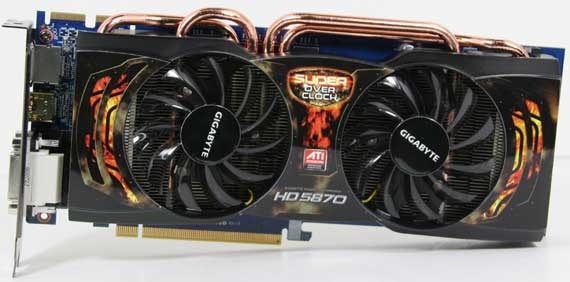Overclocked: Our Custom Radeon HD 5870 Roundup
by Ryan Smith on May 19, 2010 11:53 AM ESTConclusion
Wrapping things up, today we’ve looked at 3 different custom cards with 3 different design philosophies and 3 different sets of results.
We’ll start our conclusion with MSI’s Radeon 5870 Lighting, the purest of the overclocking specialty cards among our roundup. MSI went to bat with a design geared towards overclocking, and unfortunately they struck out. We’ll never be able to isolate just how much of this comes down to design and how much comes down to the luck of the draw for the GPU on our card, but ultimately we only got a mild overclock on top of a fairly good factory overclock.

Compared to a reference 5870 this card is a solid card, but in failing to produce an amazing overclock it’s overshadowed by our other custom cards. MSI’s Afterburner utility is a fantastic overclocking tool, but it can’t make hardware do something it’s not capable of. Perhaps with aftermarket cooling the Lightning can be a star, but anyone looking to pick one up and roll the dice on overclocking runs the risk of being as unlucky as we were. And if you’re as unlucky as us, for approximately the same price you can buy a card with a greater performance guarantee.
Next is Gigabyte’s Radeon 5870 Super Overclock, a hybrid card combining some overclocking capabilities with the highest factory overclock among our cards. As a factory overclocked card it has a very strong showing by edging out the other cards on most tests, and we believe it’s safe to call it the fastest Radeon 5870. As an overclocking card however it fails on 3 accounts: the VRMs are unable to handle higher voltages with the stock cooler, the GPU in our sample wasn’t stable even at higher voltages, and the overclocking software you have to use to control the core voltage is miserable. We can’t in good faith call this an overclocker’s card.

Even if it can’t overclock, at one point we were ready to call this the best Radeon 5870 in our roundup due to its factory overclock and cool temperatures. Then we measured the noise generated by the card and found our deal breaker – it’s entirely too loud while idling. Given that the card doesn’t have appreciably different electrical characteristics from a reference 5870 when idling, we don’t have a good reason for this card to be as loud as it is; a card doesn’t need to be that loud to dissipate 27-30W at idle. If you can stand how loud the card is at idle then it’s going to be a great choice due to its performance, temperatures, and low load noise, but we are unable to get past its high idle noise. It’s just not a good tradeoff.
This leaves us with the Sapphire Toxic 2GB, the unexpected star of our roundup. In many ways it’s an unremarkable card – it doesn’t have a dozen power phases, voltage adjustment, or voltage check points. But instead of that Sapphire focused on designing a solid card with a good factory overclock and 2GB of RAM where everyone else put 1GB, creating a fast card that manages to deliver on all of its promises and even works in a bit of end-user overclocking. It’s quieter and cooler than a reference 5870 at all times while being on average 5% faster.

It’s not quite the perfect card though as it has its share of downsides. 2GB is very forward looking, but rarely do you reap the performance benefit today while you absolutely pay the 40W-50W load power penalty for it. As a result it’s going to cost more to run and require better case ventilation than the other 5870s in our roundup. Its other downside is that outside of the cases where 2GB does help, it’s not quite as fast as the Gigabyte Radeon 5870 Super Overclock; there is a tradeoff of some performance for going with the Sapphire card. Compared to the problems that fall upon our other cards though, it's easy to see why the Sapphire Radeon 5870 Toxic 2GB is the most consistent of our cards.
Looking at the larger issues, we haven’t mentioned price too much up until now since the focus of this article is the roundup, but at $480-$500 for these cards it’s time to discuss the issue. Even when overclocked these cards are only at most 10% faster than a reference Radeon 5870 for a 20%-25% higher price. These are luxury cards that are not cost-effective, and at $500 are running right in to NVIDIA’s GeForce GTX 480.
This brings us to our final point of this roundup: looking at what an overclocked Radeon 5870 can do versus a reference clocked GTX 480. 10% is a magical number for the 5870 because 10% faster is where you need to be to start catching up to the GTX 480. At their stock clocks the Gigabyte and Sapphire cards come within 6% of the GTX 480, while overclocking reduces that to a 1-3% gap. With a good GPU, these cards can match the GTX 480 when overclocked, opening up a new avenue to buyers who want the GTX 480’s speed in games without its higher temperatures, power draw, and noise. Granted that extra RAM and overclocking splits the difference on power draw, but we’re still keeping maximum load temperatures 10W-15C below a GTX 480 and 6-8dB on load noise. At these performance levels the Gigabyte and Sapphire cards are valid alternatives to the GTX 480 and are priced competitively too. If you don’t want to spend $500 on NVIDIA’s latest and greatest, AMD’s partners have given you another path.
Long-term this also gives us an idea of where AMD would need to be with the mythical Radeon 5890 if they wanted to take the single-GPU crown back from NVIDIA. Based on our results, at around 975MHz core and 1.3GHz (5.2GHz effective) memory, we’d expect the cards to be in a dead heat. However keep in mind that this is a very big if – based on our overclocking results we find it hard to believe that AMD could get Cypress GPUs in volume that could hit 975MHz, and then there’s the matter of the memory bus. This likely isn’t something AMD can achieve without something more substantial such as a 4890-style respin, but we have certainly been caught off-guard before.










43 Comments
View All Comments
dgz - Thursday, May 20, 2010 - link
Guys, you should really use Left 4 Dead 2 instead of the original game as the sequel is way more intensive on the system. The visual difference may not be stunning but the hunger for performance is there.Jumalauta - Thursday, May 20, 2010 - link
Very interesting roundup, thank you.Seeing how idle noise is basically The Gigabyte card's only flaw, I was wondering if you tried to remedy that by controlling the fan speed with MSI Afterburner software? It's VERY handy for creating custom fan speed curves. The only question is compatibility with Gigabyte's custom card.
sneakyB - Thursday, May 20, 2010 - link
This article comes at the best of time for me, I've been trying to decide for the last two weeks wich OCed 5870 to get. But I'm surprised that there's no Asus matrix in the review, maybe it's that we have it here in Europe and it's not on sale in the US ? I would have liked to see it compared to the Gigabyte, as my usual store has both for sale.FH123 - Thursday, May 20, 2010 - link
Was the Gigabyte clocking down properly on idle? I have a an Asus 5850, based on the reference design. Once you attach 2 monitors it no longer clocks down to something like 157MHz core / 300MHz memory, but instead idles at full speed 700MHz core / 1000MHz memory with a consequent rise in noise levels, which first alerted me to the fact.Jumalauta - Thursday, May 20, 2010 - link
If you take a look at idle GPU temps, I'd say the problem is elsewhere.FH123 - Thursday, May 20, 2010 - link
Agreed.Lonyo - Thursday, May 20, 2010 - link
You dropped Wolfenstein, one of the few OpenGL games, because of the way it responds, and yet you keep in Left 4 Dead, one of the most CPU limited games there is.Sounds like a great decision.
East17 - Thursday, May 20, 2010 - link
I think that there should be another chapter included in OC cards RoundUps :1)test the cards @ default settings (already done)
2)test the cards @ OC settings (already done)
3)try to see what PCB design and options are better by excluding the cooling limitation imposed by the specific coolers and test the cards @ OC setting WITH the best VGA cooler available at that time
I think this is a good idea and should be included in future reviews IMHO .
Have a nice day!
Jumalauta - Thursday, May 20, 2010 - link
You still wouldn't get anywhere due to GPU sample variance. You would need a lot of test samples of each variety to attain even remotely conclusive results.ajlueke - Thursday, May 20, 2010 - link
The fact that these cards are typically running around the $500 mark, which is the same price tag as an Nvidia GTX 480, is a deal breaker. You pay Fermi price without the Fermi performance. Stock 5870s can be had for $400 these days, and a sub 10% performance increase with a 25% price increase hardly seems worth it. It is possible to achieve similar overclocking results for less money and with less noise with a good after market cooler.